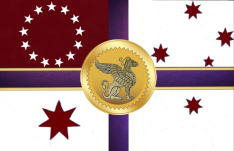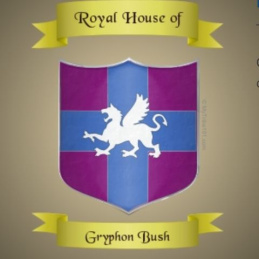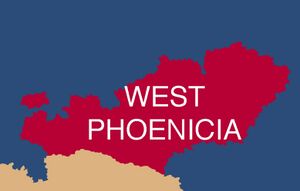User:West Phoenicia
The Confederate Empire of West Phoenicia | |
|---|---|
Anthem: "West Phoenicia in our hearts!" | |
| Capital and largest city | Melbourne-Haven |
| Official languages | English, West Phoenician |
| Demonym(s) | West Phoenician |
| Government | Confederate Constitutional Monarchy |
• Monarch | Emperor Glenton Gryphon-Bush II |
• Prime Minister | Countess Tia High |
• Deputy Prime Minister | Aaron Airè |
• Speaker of the House | Honourable Brad Atin |
| Legislature | Congress |
| Senate | |
| House of Representatives | |
| Sovereign State | |
• Independence from Greater Phoenicia | 26th January 1586 |
| Area | |
• | 783,356 km2 (302,455 sq mi) |
• Water (%) | 3 |
| Population | |
• 2019 estimate | 100 million |
| GDP (nominal) | 2020 estimate |
• Total | $5.225 trillion |
• Per capita | $55,000 |
| Currency | The Ba'al |
| Date format | dd-mm-yyyy |
| Driving side | right |
| Calling code | 03 |
| Internet TLD | .wp |
The Confederate Empire of West Phoenicia commonly called West Phoenicia, is a Confederate Constitutional Monarchy where the royal family hold almost deity-like status.
To the South is the Theocracy of Annixe Christos and The Great Empire of Eldrado.
To the north lies the Federal Republic of Alenberg and The Federated Principality of Fluvannia.
To the north and the west the Republic of Bayerland
To the North-West lies the nations of Tesyky and People's Republic of Vyeborg
West Phoenicia covers 783,356 km2 square kilometers and has has an estimated population of 100 million. West Phoenicia comprises of 53 city-states and a handful of external territories. Each of those city-states are broken down into a number of provinces/districts.
History
The Confederate Empire of West Phoenicia has a rich vibrant history. From there initial struggles to becoming a new nation. West Phoenicians pride themselves on their history.
It is a history filled with wars and civil wars, of throne disputes as siblings often married to each other fought for the privilege to wear the crown of West Phoenicia.
It is a history of love and honour weaved together with betrayel, deceit and envy.
See Main Article: History of The Confederate Empire of West Phoenicia.
Geography
West Phoenicia comprisies of 53 city states, external territories and large islands off the mainland. It is located on the Galia continent.
Each city-state has their own unique identity and culture while at the same time encompassing all the virtues, traditions and laws of West Phoenicia.
West Phoenicia is surrounded by various oceans; with the Achrinian Ocean to the north and the Rochian Ocean to the south.
West Phoenicia has rich fertile land in the north, south and east of the nation which is used for the growing of tobacco, cotton, coffee and tea; major sources of West Phoenician exports.
Gold, silver, emerald and sapphire mines are located in the western regions of the nation along with the nations main oil fields.
Melbourne-Haven; the West Phoenician capital is located on the east coast. A thriving metropolis of large man made lakes, towering skylines, fancy boutiques, the largest zoo in West Phoenicia and is also the prime centre of government, trade and commerce.
The western coast city-states have humid subtropical climates, with the exception of some of the higher elevations in the Mt Ethabaal mountain ranges of Upper West Phoenicia.
While the northern and eastern regions are classified as having a mountain temperate climate or a humid continental climate due to cooler temperatures.
The east and south east city-states have a more temperate climate with large amounts of rainfall especially in Winter and Spring.
Generally West Phoenicia has mild to hot summers and cold winters with some city-states reporting large snow falls.
Summers in West Phoenicia are generally hot and humid, with most of the city-states averaging a high of around 30 degrees during the summer months.
Winters tend to be mild to very cool especially on the east coast, increasing in coolness at higher elevations. Generally, for areas outside the highest mountains, the average overnight lows are near freezing for most of the state. East coast city-states tend to have high annual rain fall between April to September.
Royal Family
The Bush Family is the Royal Family of West Phoenicia that has ruled The Confederate Empire of West Phoenicia since 1616.
Glenton Bush I was a member of the nobility who over threw the House of Dorcas which had ruled West Phoenicia since 1586. After overthrowing the previous royal family Glenton Bush I was crowned king and began the Bush Dynasty.
The Royal Households
The Royal Households of the Confederate Empire of West Phoenicia are the collective departments which support members of the West Phoenician Royal Family.
See: West Phoenician Royal Household
Politics and Government
The Tricameral Parliament of The Confederate Empire of West Phoenicia is the legislative branch of the central government of The Confederate Empire of West Phoenicia.
It consists of four elements: the Crown, The House of Viceroys, The Senate and the House of Representatives.
The members of the House represent electoral divisions or districts across the Empire.
The members of the Senate represent the overall city-states.
The House of Viceroys are selected by the Royal Family, 13 in all. Each representing the Empire. There role is to give any government bill a final review and discussion alongside the reigning monarch. Usually they will approve the bill and the monarch will accept their outcome.
See Main Article: Government of West Phoenicia
Administrative divisions
The Confederate Empire of West Phoenicia comprises of 53 city-states and a handful of external territories. Each of those city-states are broken down into a number of provinces/districts.
See Main Article:Administrative Divisions in West Phoenicia
Political parties and elections
The Confederate Empire of West Phoenicia is a Confederate Constitutional Monarchy that has a multi party structure with 14 parties registered.
See Main Article: Political Parties in West Phoenicia
Foreign Relations
Ministry of Justice
Military
Economy
West Phoenicia has a strong thrieving capitalist mixed economy.
The highly-urbanized capital and eastern coast of West Phoenicia has a high concentration of services-based enterprises and government institutions, while northern, western, and southern areas of the nation are more rural, agricultural, and western areas are where most mining sites and cattle farms is located.
West Phoenicia has rich fertile land in the north, south and east of the nation which is used for the growing of tobacco, cotton, coffee and tea; major sources of West Phoenician exports.
Gold, silver, emerald and sapphire mines as well as cattle farms are located in the western regions of the nation along with the nations main oil fields
See Main Article: West Phoenician Economy
Infrastructure
Energy
West Phoencia's major utilities include a collection of brown-coal-fired power stations located in the western regions to supply energy to the north, east and west regions of West Phoencia's.
While in the Southern regions of West Phoenicia, alternative energy schemes such as wind and solar power are implemented to reduce the carbon emission and reliance on brown coal.
Water
West Phoenician water infrastructure includes a series of dams and reservoirs, predominantly in Central West Phoenicia that hold and collect water for much of the nation. The water collected is of a very high quality and requires little chlorination treatment, giving the water a pristine pure taste. In regional areas however, such as in the western regions, chlorination levels are much higher.The West Phoencia Water Grid consists of a number of new connections and pipelines being built across the nation. This allows water to be moved around West Phoencia to where it is needed most and reduces the impact of localized droughts in an era thought to be influenced by climate change. In New Rome and New Egypt vast mega modern aqueducts also exists to assist in non city areas
Transport
The West Phoenician road network services the population centres, with highways radiating from Melbourne-Haven to all major cities and rural centres with secondary roads interconnecting the highways to each other.
Public Transport All populated capital cities and outlining suburbs have an extensive train, trams and bus services run by private operators. Train and tram services in all major cities are run 24 hours a day.
Rural areas are connected by public and private bus services and run 24 hours a day.
Airlines
There are many airports around West Phoenicia paved or unpaved. The number of airports stands at 180.
The busiest airports in West Phoenicia are:
- Melbourne-Haven International- Jackson
- Melbourne-Haven Domestic - Jackson
- Olympia Hills Airport
- Agape Faith Airport
- Olympia Hills Domestic
- Nova Texas Regional Airport
Airline Providers:
- West Phoenicia Air is the main airline servicing both International and Domestic travel.
Healthcare
• Minister of Health: Dr Kiri Alfred
• Minister of Mental Health: Hon Vanessa Wizard
• Minister of Aged Care: Hon Inga Horne
• Secretary for Ministry of Health: Glory Hallowseve
• Chief Medical Officer: Dr Alamein Hughes
Health care in West Phoenicia is provided by both private and government institutions.
The Minister for Health, currently Dr Kiri Alfred.
The central government administers national health policy, and city-state governments administer elements of health care within their jurisdictions, such as the operation of hospitals.
MediAid is the National Public Health Care system that is available to all citizens given them access to the public health system, public dentists and public hospital access.
West Phoenicia also has Private Health for those citizens who want to pay for a better quality of heathcare, choice of doctor and access to a private hospital.
Many private hospitals also adhere to the Let them eat cake act, allowing only the aristocracy and rich access, irregardless of whether someone has private healthcare. These are known as Platinum Hospitals.
See Main Article: Healthcare in West Phoenicia
Education
Ministry of Education:
Ministers Responsible
• Minister of Education: Hon Helena Rice
• Minister of Early Childhood Development: Hon Karen Woods
Knowledge is power. West Phoenicia believes everyone is entitled to at least basic education.
Education can be broken down into;
• Pre-school • Primary School • High School • Tertiary
All four of these levels can be further broken down to Public, Private or Religious institutions.
Public: Education fully funded by the government. For all levels of education.
Private: Funded by rich families and private companies. Seen as a better education as better equipment, improved teacher to student ratio, more opportunities and resources.
Religious: Funded by religious parents and religious institutions. Considered the same level of education as private with an emphasis on religion teachings.
School attendance is mandatory from the ages of 5 to 16.
Home Schooling
Home schooling is accepted in West Phoenicia. About 9% of children are home schooled.
Religion
West Phoenicia is a God fearing nation.
It recognizes The True Path as the state religion.
The 2019 census had between 80 to 85% of the citizens identified as followers of the True Path faith.
Of Christianity, the main branches formally recognised by the Ministry of Faith are Catholicism, Protestantism, Eastern Orthodox and Mormonism which unified into a syncretism blend to create the True Path Faith and the Mega Worship Centres.
However there are a number of Catholic and Protestant churches operating under their own banner not affiliated with the True Path.
Paganism is the second major faith in the Confederate Empire of West Phoenicia,
Citizens are free to practice any faith in this devout nation as long as its not deemed banned by the Ministry of Religion. Citizens who follow banned religions or who proselytize a banned doctrine face exile or imprisonment.
See Main Article: Religion in West Phoenicia
Culture
Music & Literature
Art
Cuisine
Architecture
Fashion
Media & Cinema
National Holidays
West Phoenician's are hard workers but they also enjoy there numerous holidays. Below is a list of the national holidays.
Citizens have the right to observe which ever holidays they choose; citizens of other religions can choose to work or celebrate the holiday.
These have been declared National Holidays by the government of The Confederate Kingdom of West Phoenicia.
1 January || New Year's Day
26th January ||West Phoenicia Day
1st Feburary ||Lughnasadh
4th February ||King Glenton Gryphon-Bush II Birthday
9th-10th March|| Holi
19th March || Autumn Equinox
1st April|| All Fools Day
3rd April|| Good Friday
5th April || Resurrection Sunday
30th April || Pontifex Birthday
1st May || Beltaine May Day
8th May || Empress Angelique Birthday
10th June|| Parents Day
21st June ||Winter Solstice Day
1st August || Imbolc/ St Brigid Day
10th August || Empress Alotta Diesel-Bush Birthday
21st September || Spring Equinox
20th October|| Empress Cleopatra-Olympia Ptolemi Birthday
27th October || Diwali, Festival of Lights
31st October || Halloween
4th November || Royal Phoenicia Cup
11th November ||West Phoenicia Defence Force Day
17th December to 23rd December|| Saturnalia
21st December || Yule
22st December || Summer Solstice
22nd December- 30th December||Hanukkah
25th December || Christmas Day
26th December || Boxing Day
Sports
See Main Article: Sports in West Phoenicia
Sports are popular in West Phoenicia and the population is generally quite active and avid fans.
Baseball is the national sport and one of the most popular within West Phoenicia.
Other popular sports include Water Polo, swimming, cricket, artistic swimming basketball, fencing, sailing, tennis, and lacrosse. West Phoenicians generally gravitate towards team sports, but some individual sports also enjoy popularity, such as figure skating, archery and Rhythmic gymnastics.
The varied landscape and climate of West Phoenicia, as well as its size, allow for a variety of sports to be played.
Many sports are heavily funded by the government and private sectors with athletes expecting to excel in international sporting events.




